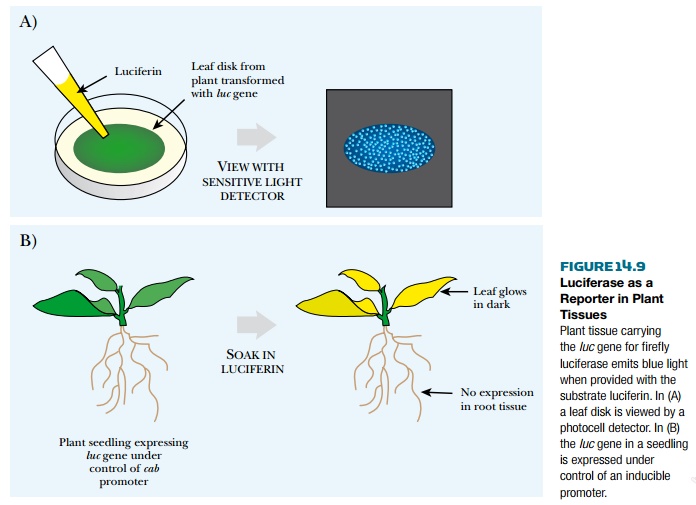Chapter: Biotechnology Applying the Genetic Revolution: Transgenic Plants and Plant Biotechnology
Detection of Inserted DNA
DETECTION
OF INSERTED DNA
How do we know whether any
DNA got into the target cells? Including a selectable marker or reporter gene
on the same segment of DNA as the transgene provides a good indicator of
whether the transgene is in the plant. One widely used reporter gene is npt,
which encodes neomycin
phosphotransferase. This enzyme inactivates the antibiotic neomycin by attaching a phosphate group. Cells
successfully incorporating DNA carrying the npt
gene are no longer killed by neomycin. This allows direct selection of
transformed cells as treatment with neomycin kills any cells that did not
integrate the DNA.
A nonlethal diagnostic method is to include a reporter gene that codes for luciferase. This enzyme emits light when provided with its substrate, luciferin (Fig. 14.9A). Luciferase is found naturally in assorted luminous creatures, from fireflies to luminous squid. The genes encoding luciferase from eukaryotes and prokaryotes are referred to respectively as luc and lux. Although both kinds of luciferase produce light, the chemical nature of their luciferins and mechanism of the reactions are different. If DNA carrying the eukaryotic luc gene is successfully incorporated into a target plant cell, light will be emitted when luciferin is added. In this case, the luciferin is oxidized using endogenous ATP and O2. Although high-level expression of luciferase can be seen with the naked eye, usually the amount of light is small and must be detected with sensitive electronic apparatus such as a scintillation counter, a sensitive photocell detector, or a CCD camera.

This reporter gene also has
another advantage. The luciferase protein is not stable for long in the plant,
and so the amount of active protein correlates with the level of gene
expression at any given time. Therefore, this reporter gene can be used to test
the activity of specific promoters. For example, if the cab promoter controls the expression of the luc gene, then luciferase is only made when this promoter is turned
on in the plant. Transgenic Arabidopsis
plants containing this construct only emit light from luciferase in
photosynthetic tissue that is exposed to light—the natural conditions that
induce expression of the plant cab
gene (see Fig. 14.9B). Other promoters can also be studied using the luc gene.
Once cells successfully
expressing the reporter gene are identified, they are regenerated into plants
using tissue culture techniques. The plants obtained are then screened for the
gene of interest or transgene. Techniques such as PCR can confirm the presence of the transgene.
Further analyses such as Southern blots can pinpoint the relative chromosomal
location of the inserted transgene. Several plant genomes have now been fully
sequenced, so localizing transgenes has recently become much easier.
Related Topics